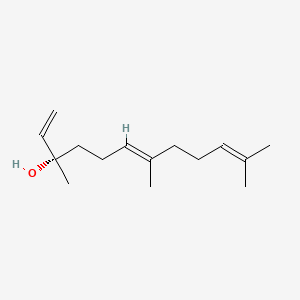| MeSH term | MeSH ID | Detail |
|---|---|---|
| Stomach Ulcer | D013276 | 75 associated lipids |
| Dermatomycoses | D003881 | 17 associated lipids |
| Leishmaniasis | D007896 | 19 associated lipids |
Nerolidol
Nerolidol is a lipid of Prenol Lipids (PR) class. Nerolidol is associated with abnormalities such as Hyperostosis, Diffuse Idiopathic Skeletal, Corn of toe, Infection, Leishmaniasis and Leishmaniasis, Cutaneous. The involved functions are known as Protein Biosynthesis, Anabolism, Signal, volatile substances and terpene biosynthetic process. Nerolidol often locates in Protoplasm, Plastids, Cytoplasmic matrix, Body tissue and Mitochondria. The associated genes with Nerolidol are Genome, Genes, Plant, Homologous Gene, Recombinant Proteins and monoterpene synthase. The related lipids are Pinene, prenol and Sterols.
Cross Reference
Introduction
To understand associated biological information of Nerolidol, we collected biological information of abnormalities, associated pathways, cellular/molecular locations, biological functions, related genes/proteins, lipids and common seen animal/experimental models with organized paragraphs from literatures.
What diseases are associated with Nerolidol?
Nerolidol is suspected in Plasmodium falciparum infection, Infection, Corn of toe, Leishmaniasis, Leishmaniasis, Cutaneous, Exanthema and other diseases in descending order of the highest number of associated sentences.
Related references are mostly published in these journals:
| Disease | Cross reference | Weighted score | Related literature |
|---|
Possible diseases from mapped MeSH terms on references
We collected disease MeSH terms mapped to the references associated with Nerolidol
PubChem Associated disorders and diseases
What pathways are associated with Nerolidol
Lipid pathways are not clear in current pathway databases. We organized associated pathways with Nerolidol through full-text articles, including metabolic pathways or pathways of biological mechanisms.
Related references are published most in these journals:
| Pathway name | Related literatures |
|---|
PubChem Biomolecular Interactions and Pathways
Link to PubChem Biomolecular Interactions and PathwaysWhat cellular locations are associated with Nerolidol?
Visualization in cellular structure
Associated locations are in red color. Not associated locations are in black.
Related references are published most in these journals:
| Location | Cross reference | Weighted score | Related literatures |
|---|
What functions are associated with Nerolidol?
Related references are published most in these journals:
| Function | Cross reference | Weighted score | Related literatures |
|---|
What lipids are associated with Nerolidol?
Related references are published most in these journals:
| Lipid concept | Cross reference | Weighted score | Related literatures |
|---|
What genes are associated with Nerolidol?
Related references are published most in these journals:
| Gene | Cross reference | Weighted score | Related literatures |
|---|
What common seen animal models are associated with Nerolidol?
There are no associated biomedical information in the current reference collection.
NCBI Entrez Crosslinks
All references with Nerolidol
Download all related citations| Authors | Title | Published | Journal | PubMed Link |
|---|---|---|---|---|
| Di Campli E et al. | Activity of tea tree oil and nerolidol alone or in combination against Pediculus capitis (head lice) and its eggs. | 2012 | Parasitol. Res. | pmid:22847279 |
| Gonçalves O et al. | Evaluation of the mutagenicity of sesquiterpenic compounds and their influence on the susceptibility towards antibiotics of two clinically relevant bacterial strains. | 2011 | Mutat. Res. | pmid:21453784 |
| Navarro-Moll MC et al. | In vitro and in vivo activity of three sesquiterpenes against L(3) larvae of Anisakis type I. | 2011 | Exp. Parasitol. | pmid:20932829 |
| PÃculo F et al. | In vivo genotoxicity assessment of nerolidol. | 2011 | J Appl Toxicol | pmid:21089164 |
| Tamogami S et al. | Conversion of airborne nerolidol to DMNT emission requires additional signals in Achyranthes bidentata. | 2011 | FEBS Lett. | pmid:21510937 |
| Kiem PV et al. | Chemical constituents of the rhizomes of Hedychium coronarium and their inhibitory effect on the pro-inflammatory cytokines production LPS-stimulated in bone marrow-derived dendritic cells. | 2011 | Bioorg. Med. Chem. Lett. | pmid:22071304 |
| Nakano C et al. | Identification and characterization of the linalool/nerolidol synthase from Streptomyces clavuligerus. | 2011 | Chembiochem | pmid:21910204 |
| Yang K et al. | Toxicity of Rhododendron anthopogonoides essential oil and its constituent compounds towards Sitophilus zeamais. | 2011 | Molecules | pmid:22143541 |
| Song WF et al. | [Analyze on chemical compositions of Dalbergia odorifera essential oils extracted by CO2-supercritical-fluid-extraction and steam distillation extraction]. | 2011 | Zhong Yao Cai | pmid:22506398 |
| Mabrouk S et al. | Chemical composition of essential oils from leaves, stems, flower heads and roots of Conyza bonariensis L. from Tunisia. | 2011 | Nat. Prod. Res. | pmid:21240765 |
